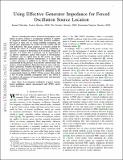Using Effective Generator Impedance for Forced Oscillation Source Location
Author(s)
Chevalier, Samuel C.; Vorobev, Petr; Turitsyn, Konstantin
DownloadAccepted version (1.695Mb)
Open Access Policy
Open Access Policy
Creative Commons Attribution-Noncommercial-Share Alike
Terms of use
Metadata
Show full item recordAbstract
Locating the sources of forced low-frequency oscillations in power systems is an important problem. A number of proposed methods demonstrate their practical usefulness, but many of them rely on strong modeling assumptions and provide poor performance in certain cases for reasons still not well understood. This paper proposes a systematic method for locating the source of a forced oscillation by considering a generator's response to fluctuations of its terminal voltages and currents. It is shown that a generator can be represented as an effective admittance matrix with respect to low-frequency oscillations, and an explicit form for this matrix, for various generator models, is derived. Furthermore, it is shown that a source generator, in addition to its effective admittance, is characterized by the presence of an effective current source, thus giving a natural qualitative distinction between source and nonsource generators. Detailed descriptions are given of a source detection procedure based on this developed representation, and the method's effectiveness is confirmed by simulations on the recommended testbeds (e.g., WECC 179-bus system). This method is free of strong modeling assumptions and is also shown to be robust in the presence of measurement noise and generator parameter uncertainty.
Date issued
2018-11Department
Massachusetts Institute of Technology. Department of Mechanical EngineeringJournal
IEEE Transactions on Power Systems
Publisher
Institute of Electrical and Electronics Engineers
Citation
S. C. Chevalier, P. Vorobev and K. Turitsyn, "Using Effective Generator Impedance for Forced Oscillation Source Location," in IEEE Transactions on Power Systems, vol. 33, no. 6, pp. 6264-6277, Nov. 2018.
Version: Author's final manuscript
ISSN
0885-8950
1558-0679